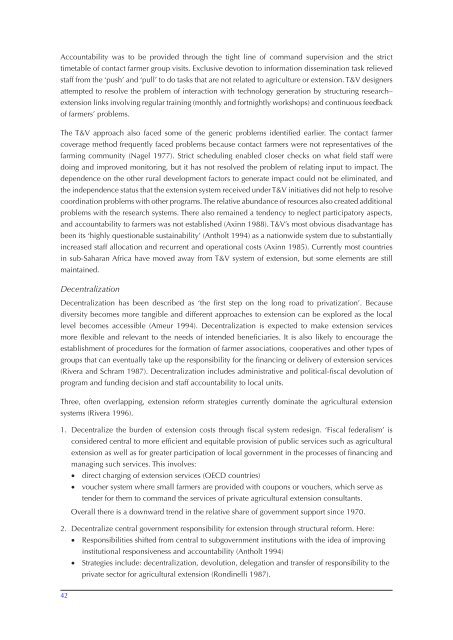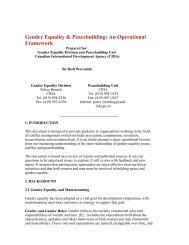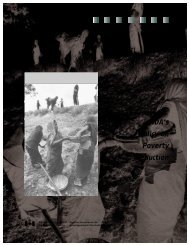Concepts and practices in agricultural extension in developing ...
Concepts and practices in agricultural extension in developing ...
Concepts and practices in agricultural extension in developing ...
- No tags were found...
You also want an ePaper? Increase the reach of your titles
YUMPU automatically turns print PDFs into web optimized ePapers that Google loves.
Accountability was to be provided through the tight l<strong>in</strong>e of comm<strong>and</strong> supervision <strong>and</strong> the stricttimetable of contact farmer group visits. Exclusive devotion to <strong>in</strong>formation dissem<strong>in</strong>ation task relievedstaff from the ‘push’ <strong>and</strong> ‘pull’ to do tasks that are not related to agriculture or <strong>extension</strong>. T&V designersattempted to resolve the problem of <strong>in</strong>teraction with technology generation by structur<strong>in</strong>g research–<strong>extension</strong> l<strong>in</strong>ks <strong>in</strong>volv<strong>in</strong>g regular tra<strong>in</strong><strong>in</strong>g (monthly <strong>and</strong> fortnightly workshops) <strong>and</strong> cont<strong>in</strong>uous feedbackof farmers’ problems.The T&V approach also faced some of the generic problems identified earlier. The contact farmercoverage method frequently faced problems because contact farmers were not representatives of thefarm<strong>in</strong>g community (Nagel 1977). Strict schedul<strong>in</strong>g enabled closer checks on what field staff weredo<strong>in</strong>g <strong>and</strong> improved monitor<strong>in</strong>g, but it has not resolved the problem of relat<strong>in</strong>g <strong>in</strong>put to impact. Thedependence on the other rural development factors to generate impact could not be elim<strong>in</strong>ated, <strong>and</strong>the <strong>in</strong>dependence status that the <strong>extension</strong> system received under T&V <strong>in</strong>itiatives did not help to resolvecoord<strong>in</strong>ation problems with other programs. The relative abundance of resources also created additionalproblems with the research systems. There also rema<strong>in</strong>ed a tendency to neglect participatory aspects,<strong>and</strong> accountability to farmers was not established (Ax<strong>in</strong>n 1988). T&V’s most obvious disadvantage hasbeen its ‘highly questionable susta<strong>in</strong>ability’ (Antholt 1994) as a nationwide system due to substantially<strong>in</strong>creased staff allocation <strong>and</strong> recurrent <strong>and</strong> operational costs (Ax<strong>in</strong>n 1985). Currently most countries<strong>in</strong> sub-Saharan Africa have moved away from T&V system of <strong>extension</strong>, but some elements are stillma<strong>in</strong>ta<strong>in</strong>ed.DecentralizationDecentralization has been described as ‘the first step on the long road to privatization’. Becausediversity becomes more tangible <strong>and</strong> different approaches to <strong>extension</strong> can be explored as the locallevel becomes accessible (Ameur 1994). Decentralization is expected to make <strong>extension</strong> servicesmore flexible <strong>and</strong> relevant to the needs of <strong>in</strong>tended beneficiaries. It is also likely to encourage theestablishment of procedures for the formation of farmer associations, cooperatives <strong>and</strong> other types ofgroups that can eventually take up the responsibility for the f<strong>in</strong>anc<strong>in</strong>g or delivery of <strong>extension</strong> services(Rivera <strong>and</strong> Schram 1987). Decentralization <strong>in</strong>cludes adm<strong>in</strong>istrative <strong>and</strong> political-fiscal devolution ofprogram <strong>and</strong> fund<strong>in</strong>g decision <strong>and</strong> staff accountability to local units.Three, often overlapp<strong>in</strong>g, <strong>extension</strong> reform strategies currently dom<strong>in</strong>ate the <strong>agricultural</strong> <strong>extension</strong>systems (Rivera 1996).1. Decentralize the burden of <strong>extension</strong> costs through fiscal system redesign. ‘Fiscal federalism’ isconsidered central to more efficient <strong>and</strong> equitable provision of public services such as <strong>agricultural</strong><strong>extension</strong> as well as for greater participation of local government <strong>in</strong> the processes of f<strong>in</strong>anc<strong>in</strong>g <strong>and</strong>manag<strong>in</strong>g such services. This <strong>in</strong>volves:• direct charg<strong>in</strong>g of <strong>extension</strong> services (OECD countries)• voucher system where small farmers are provided with coupons or vouchers, which serve astender for them to comm<strong>and</strong> the services of private <strong>agricultural</strong> <strong>extension</strong> consultants.Overall there is a downward trend <strong>in</strong> the relative share of government support s<strong>in</strong>ce 1970.2. Decentralize central government responsibility for <strong>extension</strong> through structural reform. Here:• Responsibilities shifted from central to subgovernment <strong>in</strong>stitutions with the idea of improv<strong>in</strong>g<strong>in</strong>stitutional responsiveness <strong>and</strong> accountability (Antholt 1994)• Strategies <strong>in</strong>clude: decentralization, devolution, delegation <strong>and</strong> transfer of responsibility to theprivate sector for <strong>agricultural</strong> <strong>extension</strong> (Rond<strong>in</strong>elli 1987).42





